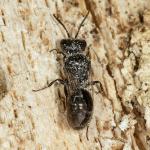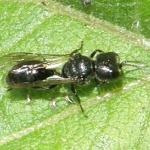Richards (1980) and other authors separated this species from P. clypealis Thomson, but recently the two species have been synonymised under P. morio. Lomholdt (1984) refers to the two as separate species and places them in a separate genus, Ceratophorus.
In discussing the two synonymised species, Falk (1991) states that P. morio occurs from southern England northwards to south Wales, south Lancashire and north-east Yorkshire, a pattern shown to largely hold true for this atlas project.
Bitsch et al. (2001) note its occurrence in north and central Europe, Turkey, Kazakhstan and Japan. Lomholdt (1984) describes its distribution in Fennoscandia as being patchy but locally frequent.
Shirt (1987) listed this species as being Rare (RDB3), separate from P. clypealis, which was also accorded RDB3 status. However, the status for the combined species pair was revised to Notable B (now known as Nationally Scarce Nb) by Falk (1991).
Recorded from a range of habitats where suitable nesting habitat is found, including, occasionally, gardens.
Late May to August.
In keeping with other Pemphredon species, aphids (Hemiptera: Aphididae) are the prey species for this wasp.
This species nests in old wood, including fence posts and house timbers in sunny locations. Lomholdt (1984) describes a branched nest tunnel, with each side-branch ending in a cell.
No data available.
No data available.
2012



